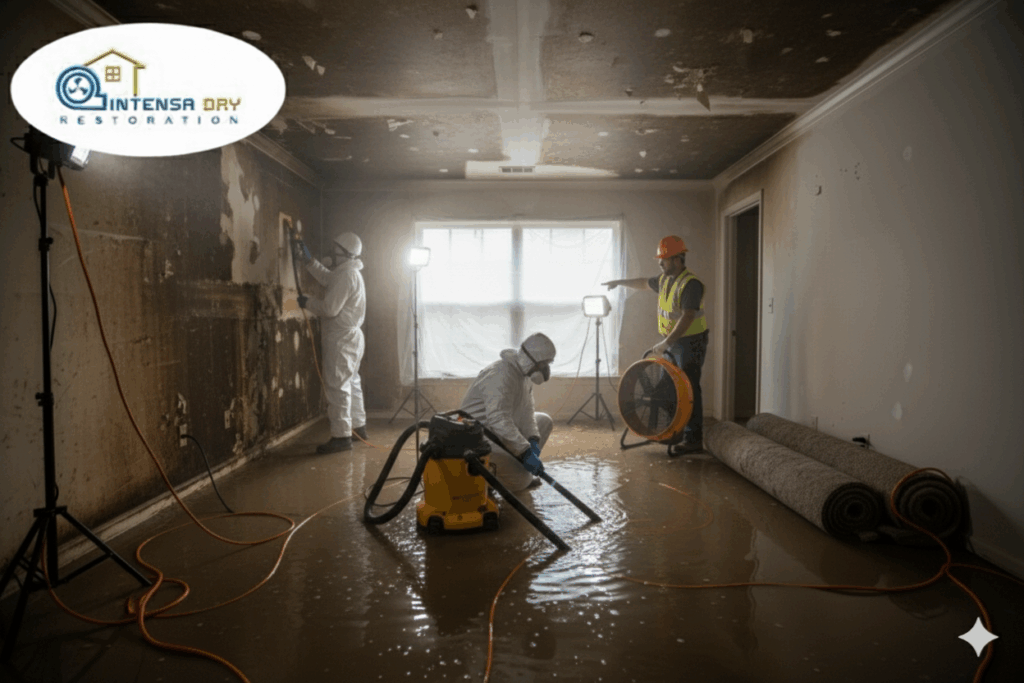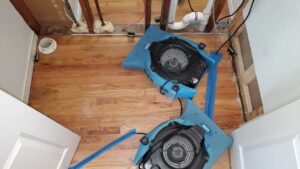Blogs
7 Hidden Signs of Water Damage in Your North Texas Home

Water damage is a problem that often sneaks up on you. By the time you notice the signs, the damage might already be serious. In North Texas, storms, flash floods, plumbing failures, and high humidity are common threats. Many homeowners assume they’ll notice a major leak right away. The truth is, most water damage happens quietly. It lurks behind your walls, under your floors, or inside your ceilings, long before you see it.
At Intensa Dry, we specialize in water damage restoration, mitigation, and reconstruction across the Dallas–Fort Worth (DFW) area. We have seen firsthand how early detection can save homeowners thousands of dollars. It also protects your property’s structure and value.
The best defense is knowing what to look for. Here are the 7 hidden signs of water damage that North Texas homeowners should never ignore.
1. The Persistent Musty or Damp Odor
One of the first signs of hidden water damage is a musty or damp smell that won’t go away. This earthy odor is especially noticeable after rain or in high-moisture rooms like basements, closets, or bathrooms. Even if you don’t see visible leaks, this smell usually means moisture is trapped somewhere. Therefore, mold could already be forming behind the walls or under the floors.
2. Unexplained Discoloration and Stains
You might notice stains or discolored patches on your walls, ceilings, or floors. Yellow spots or dark areas often appear around windows, plumbing lines, or baseboards. Crucially, these stains can indicate slow, continuous leaks. They might seem harmless at first, but in reality, they often point to deeper water intrusion inside your home’s structure.
3. Peeling Paint and Bubbling Wallpaper
If paint or wallpaper starts to bubble, crack, or peel, consider it a serious warning sign. When moisture gets behind a surface, it breaks the bond holding the paint or paper in place. If the drywall feels soft or damp when you touch it, consequently, you are likely dealing with hidden water damage underneath.
4. Warped, Soft, or Buckling Floors
Your floors can tell you a lot about moisture issues. Warped or buckling hardwood and laminate floors are a common sign of moisture trapped beneath. If your floors feel soft, uneven, or spongy when you walk across them, in other words, water might be pooling below the surface.
5. Rust or Corrosion on Non-Water Items
Look closely at your home’s metal components. Rust or corrosion on pipes, plumbing fixtures, or even small nails in the drywall can signal excess humidity or hidden leaks nearby. Furthermore, these are small details that many people overlook, but they serve as important clues that something isn’t right within the environment.
6. Increased Allergy or Respiratory Symptoms
If you or your family start experiencing more allergy symptoms, coughing, or congestion in certain rooms, mold could be the cause. Mold growth results from hidden moisture. It develops within 24 to 48 hours after a leak and spreads quickly, affecting both air quality and your family’s health. Thus, an increase in symptoms should prompt an investigation.
7. Sudden Spikes in Water Bills or Humidity
A final clue is an unexpected spike in your water bill or indoor humidity levels. Unexplained increases in water usage or moisture can point directly to a hidden leak within your plumbing system. Monitoring your water consumption and indoor humidity helps you catch these issues early.
Why Immediate Action is Critical in DFW
Early detection is key to preventing serious and costly problems. In North Texas, homes often sit on expansive clay soil. Long-term moisture exposure can cause foundation cracks, weakened drywall, and severe structural damage. Moreover, unchecked mold growth will dramatically affect your home’s air quality and lower its resale value.
If you suspect water damage, start with a quick visual check after storms or high-humidity days. Look for the signs mentioned above. Most importantly, do not hesitate to call in a professional mitigation specialist.
Don’t Guess, Get a Professional Moisture Inspection
At Intensa Dry, we offer free moisture inspections across DFW. We use advanced tools like thermal imaging and moisture meters. Our certified technicians can find leaks hidden behind walls and under floors. We act fast to dry, clean, and restore your property. We also work directly with home insurance providers to make the entire process smooth and stress-free.
The sooner you act, the more damage you can prevent.
If you’ve noticed any warning signs of water damage in your North Texas home, or you simply want peace of mind, contact Intensa Dry today for your free moisture inspection. We’re available 24/7 across the Dallas–Fort Worth area to help you protect your home from hidden leaks, mold, and water damage before it turns into a costly repair.

